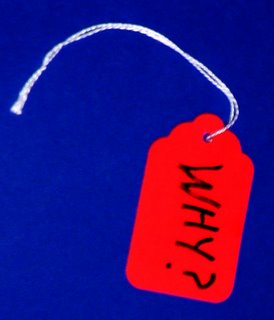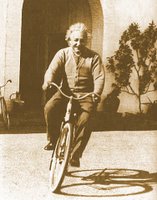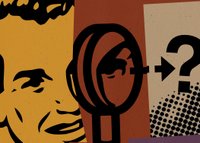 In Red Tag, Part I we realized that most of us are car addicts, that we ride in our cars without thinking about it, and that this is not a green habit. We learned a simple technique to create awareness of our mobility choices by “red tagging” our car keys. The tag reads “How?” and “Why?” so that we will ask ourselves the hard questions – and make a conscious decision: “How will I get there?” and “Why do I have to ride a car?” In Red Tag, Part II, we examined the basis for the excuses we offer ourselves -- both real and trumped up. Today, some workarounds for some of the false excuses we offer ourselves.
In Red Tag, Part I we realized that most of us are car addicts, that we ride in our cars without thinking about it, and that this is not a green habit. We learned a simple technique to create awareness of our mobility choices by “red tagging” our car keys. The tag reads “How?” and “Why?” so that we will ask ourselves the hard questions – and make a conscious decision: “How will I get there?” and “Why do I have to ride a car?” In Red Tag, Part II, we examined the basis for the excuses we offer ourselves -- both real and trumped up. Today, some workarounds for some of the false excuses we offer ourselves.T he whole point of the Red Tag process is to create awareness. The Red Tag does not offer non-auto alternatives; it does not stop one from riding a car. It can create awareness, and awareness is the first step. If you are any kind of decent human being, the awareness should result, ultimately, in some action. Or maybe just a little guilt.
The problem is, guilt leads to excuses, excuses lead to rationalizations, which in turn relieve the guilt and any interest in that pesky awareness -- and thus we have simply dug the car-riding rut deeper.
Today I offer a few of the rationalizations I have tried, or seen tried, and some workarounds.
More Ways to Say "No" than "Yes" to the Car
At the outset one needs to realize that there are many ways to avoid the car in any given situation. Like the Pasadena Walks! slogan says "Walk Bike Ride"
 are almost always competing alternatives. So if transit turns your 30 minute commute into a 90 minute nightmare, consider driving a bike, or bike mixed with a different transit mode. The key is not to give up on a mode if it fails for a particular trip, and not to ditch all non-auto choices if one doesn't work the first time.
are almost always competing alternatives. So if transit turns your 30 minute commute into a 90 minute nightmare, consider driving a bike, or bike mixed with a different transit mode. The key is not to give up on a mode if it fails for a particular trip, and not to ditch all non-auto choices if one doesn't work the first time.That reminder having been served, here are some of the most common rationalizations I have encountered in my own brain and some ways I have found to over come them. They may work for you, or they may not -- but, again, if we are willing to admit that we are car-addicted, and think about alternative, we are well on the way to recovery.
That's Too Far To Walk (Or Bike):
Remember way back in Part I, when I asked people if they would drive 1250 feet to go to the store and everyone vehemently said "no!" When I asked if they had to drive a car for trip of 2500 feet? "Nooooo!" But when I ask the same group if they would walk a half mile to the store, they will often say that that its is too far? Remember?
Well, remember too that a half mile is only about 2500 feet.
As car riders, our concept of distance is often skewed. Frequent car driver's often have trouble estimating short distances, especially in the city. A store five miles away seems almost as close as the store that is only a mile and a half away.
Why? I'm not sure, but it may have something to do with driving overhead.
See, studies have shown that for any trip under about 15 minutes on surface streets, a bike is often quicker. That is, portal-to-portal you may only be able to ride a car two or three miles in fifteen minutes (when you include the getting out of the car, the riding in traffic, parking the car, walking the quarter mile across the parking lot, etc.)
The same three mile trip on a bike will only take 5-10 minutes, as a bike does not get held up the same way in traffic as a car, and can usually park right at the door of the destination.
Funny Story: The Bike and The Sports Car
I was once riding my bike to run an errand. I pulled up beside a white car sports car, at a traffic signal. In the car was a goodlooking 30-something gentleman at the
 wheel, and a similarly attractive thirty-something female passenger. I looked the car and the occupants over appraisingly -- and got that testosterone-fueled look from the driver that said "Mine. Car, Girl, Mine. Haha!" When the light turned green, he peeled out a little and took off, only to be brought up at the next light. He'd done an average of about 45 MPH between lights (in a 30 MPH zone, I might add).
wheel, and a similarly attractive thirty-something female passenger. I looked the car and the occupants over appraisingly -- and got that testosterone-fueled look from the driver that said "Mine. Car, Girl, Mine. Haha!" When the light turned green, he peeled out a little and took off, only to be brought up at the next light. He'd done an average of about 45 MPH between lights (in a 30 MPH zone, I might add).As he's sitting at the light, I'm pluggin' along effortlessly at 15-20 MPH on my bike. I pull up beside them at that light, which is still red. I look 'em over appraisingly, the guy pretends not to see me, the woman smiles. Light turns green. They whiz out and soon get stopped at the next light.
A moment later, I glide up and we site together at that light too. I'm smiling now, and neither of them want to see me.
This goes on for nearly three miles. We left a spot about 50 yards from my house at the same time, and we got to my errand destination at exactly the same time. I got a little exercise and didn't burn any fossil fuels. They guy with his manhood in the gas tank got embarrassed.
It's Still Too Far
If you grocery- shop 15 miles from home, then its probably too far to walk, and even transit combined with walking would be a pain, and not at all an Easy Green thing to do. One can bike 15 miles pretty easily, but my personal comfort level is about 10 miles (each way), and then
 mostly when I have been biking a lot of shorter errands during the preceding weeks. So, yes, 10 or 15 miles is probably too far.
mostly when I have been biking a lot of shorter errands during the preceding weeks. So, yes, 10 or 15 miles is probably too far.Which is exactly the point. One of the keys to reduced auto dependence is "re-localization." Now this term can mean a lot of rigorous-green things to some seriously green people, but for our purposes, let's keep it easy: Shop nearer to home. (For that matter, work and play there more too.)
The odds are pretty fair that you are shopping at a grocery market that was near to you at a prior residence but is still on your way to work, mostly, so you keep shopping there. Or it is on your way home from work, regardless, and is a store you like, but it is pretty far away.
Of course, not every town has everything you need within five miles like, oh, say, Pasadena. But there is a lot more nearby than we often realize.
And its not just shopping. Doctors, dentists, shopping malls, downtowns, our jobs, schools, recreation and more all tend to be more than five miles from home if we are auto dependent. We just don't see things that are right around the corner, or we make the local stop part of a bigger errand so that it easier to do in the car.
Addicts: Creating Car Use
 Note well that last bit: We make the local stops part of a big round of errands, or combine them with a far-away trip so they are easier to do in the car!!
Note well that last bit: We make the local stops part of a big round of errands, or combine them with a far-away trip so they are easier to do in the car!!Watch yourself for a couple of days. You'll see.
So: You can choose to go to a closer place and use a different mode. Even if only sometimes, its a start! And you can avoid tagging nearby errands onto a bigger car trip. The interesting thing about this is we often discover new destinations that let us make the entire trip closer to home.
I Don't Have the Time
Closely related to "it's too far" is "I don't have the time." First, see point one: For a round trip that would be under 15 minutes in a car, the bike is probably faster. Second, by re-localizing where we do some of our business, we do have the time to make the shorter trip in a non-auto mode.
My favorite story in this respect is the person who told me that they would, if they only could, walk or bike to the market but then they wouldn't have time to take the car to the gym and stop at the market on the way home.
"Really," I asked. "What kind of work out do you do?"
"Oh, a light cardio; stationary bike, stairmaster, some light weights for 'mommy arms' " this person said
"Oh," I said, and just let it sink in. Eventually it occurred to her -- as it just occurred to some of you -- that riding a car to the gym to use a fake bicycle made no sense at all! A real bike ride to the market and back accomplished the same two errands, and at no expense of fossil fuel!
Coming Soon:
But I have to Carry Stuff! or
Bike Trailers & Granny Carts For All!

No comments:
Post a Comment